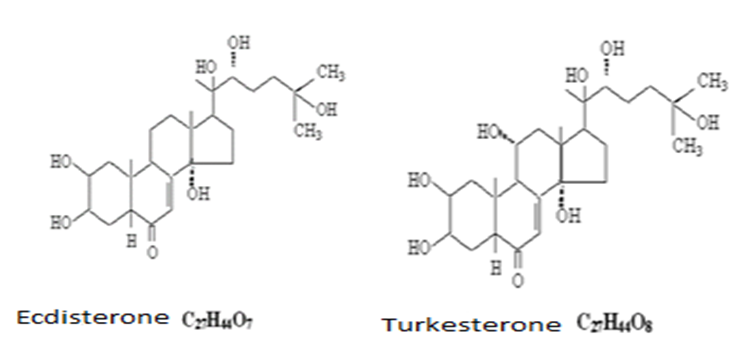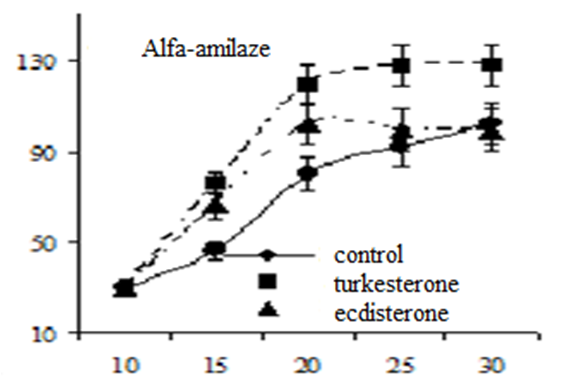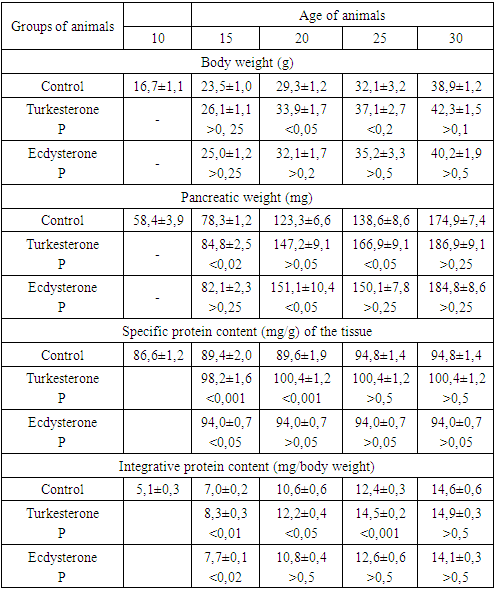Kimsanova G. A.1, Dustmatova G. A.1, Topilova F. M.1, Aliyeva R. A.2, Ne’matova M.1, Eraliyeva G.1
1Researcher, Andijan State University, Uzbekistan
2Researcher, Andijan State Institute of Foreign Languages, Uzbekistan
Copyright © 2024 The Author(s). Published by Scientific & Academic Publishing.
This work is licensed under the Creative Commons Attribution International License (CC BY).
http://creativecommons.org/licenses/by/4.0/

Abstract
In early ontogenesis, due to the extreme susceptibility of the digestive system to various social and man-made influences, the body's ability to absorb nutrients shifts. Disruption of digestive processes in a growing organism negatively affects all functional systems, health and performance in subsequent periods of life. In this regard, the study of the physiological effects and pharmacological effects of herbal medicines used in medicine is of scientific and practical importance. In many scientific centers of the world, special attention is paid to the identification of phytopreparations that neutralize the negative effects of alimentary and non-alimentary factors on the body and have corrective properties. Anabolic, stress-protective, antioxidant, antiradical, bactericidal, immune-modulating, adaptogenic, hypoglycemic and anti-inflammatory properties of phytoecdysteroids have been revealed. In this regard, the study of the effects of phytoecdysteroids on the formation of hydrolytic systems for the digestion of carbohydrates, proteins and fats and the optimization of assimilation of essential nutrients in normal and stressful conditions, as well as the prevention and correction of digestive insufficiency are of great scientific and practical importance.
Keywords:
Turkesterone, Ecdysterone, Pancreas, α-amylase
Cite this paper: Kimsanova G. A., Dustmatova G. A., Topilova F. M., Aliyeva R. A., Ne’matova M., Eraliyeva G., Influence of Turkesterone and Ecdysterone on the Development of α-Amylase Activity in Growing Rats, American Journal of Medicine and Medical Sciences, Vol. 14 No. 5, 2024, pp. 1328-1331. doi: 10.5923/j.ajmms.20241405.38.
1. Introduction
Phytoecdysteroids, which are increasingly attracting the attention of researchers, are among the most numerous and widespread compounds in the organic world [1]. Currently, it is known that many phytoecdysteroids have a wide range of biological effects, which manifests itself in a pronounced regulatory effect on a number of physiological and biochemical processes in organs and tissues [2,3]. In this regard, it was of particular interest to study the possible corrective effect of phytoecdysteroids on the development of functional systems in early ontogenesis, i.e., during the period when the metabolic effect of any biologically active substances, including steroids, is manifested especially clearly [4]. It is believed that in humans and other mammals, under certain conditions, ecdysteroids may have hormone-like or vitamin-like actions, but are not associated with this property, which is characteristic of endogenous hormones [5]. Previously, we showed that in the hydrolytic systems of the small intestine, animal and plant steroids have an identical inducing effect, leading to the induction of the activity of some carbohydrase of the small intestine involved in the final stage of carbolysis of carbohydrates [6,7,8,9]. However, there is no information on the effect of phytoecdysteroids on the activity of digestive enzymes of the initial stages of hydrolysis of carbohydrates, such as α-amylase.The purpose of this work is to study the effect of phytoecdysteroids on the development of pancreatic α-amylase activity in a growing organism.
2. Materials and Methods of Research
The experiments were performed on growing mongrel white rats. After birth, rats from different litters were mixed and left with 8 individuals for each lactating female. The animals were divided into 2 experimental and one control group. In the first experimental group, turkesterone was administered to rats daily orally at a dose of 2 mg / kg from the 10th to the 20th day of postnatal life. In the second experimental group, ecdysterone was orally administered to rats at the same time and at the same doses. The control group of rats was injected with a solvent in the same way. The animals were kept without restriction of access to water and food.Turkesterone and ecdysterone (Fig. 1) were obtained from the plant Ajuga turkestanica at the Institute of Chemistry of Plant Compounds of the Academy of Sciences of the Republic of Uzbekistan. | Figure 1. Structural formulas, phytoecdysteroids |
The activity of pancreatic enzymes was determined before the administration of drugs in 10-day-old rats, as well as on the 15th, 20th, 25th and 30th days of postnatal life. To do this, 5-6 individuals from each group were decapitated under light ether anesthesia. After slaughter, the abdominal cavity was opened and, having separated the pancreas in cold conditions, it was dried with filtered paper. Then the pancreas, weighed, cut into small pieces, poured with cold Ringer's solution (pH-7.3) and homogenized with a Teflon pestle at 300 rpm for a minute.In the obtained homogenates, the protein content was determined (Lowry et al., 1951) [10], and the activity of α-amylase (CF 3.2.1.1) (Ugolev, 1969) [6]. Statistical processing of the results was carried out using the Student-Fisher test.
3. Results and Discussion
The results showed that both ecdysterone and Turkesterone lead to an increase in pancreatic α-amylase activity in the developing organism. Changes in pancreatic α amylase activity in growing rats after administration of phytoecdysteroids are presented in Figure 2. | Figure 2. The effect of turkesterone and ecdysterone on the activity of pancreatic α-amylase in growing rats |
On the axis of abscia - the age of rats in days; on the axis of ordinate activity of enzymes in conventional units. An asterisk indicates differences that are significant compared to the control.It can be seen that as the rats grew and developed, the activity of α-amylase in the control group of rats increased. In 30-day-old rats, it was twice as much as in 10-day-old rats.However, an increase in enzyme activity in rats treated with phytoecdysteroids was manifested at a higher level. Thus, in 15-, 20- and 30-day-old rats treated with turkesterone, the activity of α-amylase was 2,7; 2.1 and 1,6 times more increased than in rats of the control group of the same age. In rats receiving ecdysterone injection, enzyme activity increased 1,4-fold at 15 days of age and 1,5-fold at 20 days of age. In 30-day-old rats, no significant differences in this indicator between the experience and the control were recorded. Thus, chronic injections of phytoecdysteroids lead to a premature increase in the activity of pancreatic α-amylase in growing rats. At the same time, the inducing effect of exogenous turkesterone is more pronounced than that of ecdysterone.The synthesis and secretion of α-amylase involved in the initial stages of carbohydrate digestion in the small intestine takes place in the acinar cells of the pancreas. It is known that the change in the ability of the organs of the gastrointestinal tract to digest nutrients is due to not only the secretion of enzymes, which are proteins in nature, but also to the volume and mass of the secretory organ. The mass of the digestive organs and body weight are integral indicators reflecting the state of the body and, including the status of digestion. Below are data on changes in body weight, pancreas and the content of specific and integrative protein in the organ (Table 1).Table 1. Effect of oral administration of phytoecdysteroids on body weight and pancreas in growing rats (M±m; at n=6-7)
 |
| |
|
It can be seen from the table that the introduction of turkesterone causes a tendency to increase body weight in growing rats, which was significant at 20 days of age of animals. The introduction of ecdysterone, however, caused some tendency to increase body weight, which, however, was statistically insignificant. Pancreatic weight in turkesterone-treated rats increased by 8.3%; 9.4% and 9.9% in 15-day-old, 20-day-old and 25-day-old rats treated with turkesterone, respectively. On the 30 th day of postnatal life, this indicator was smoothed out in animals of the control and experimental groups.The specific protein content also changed slightly in animals after treatment with phytoecdysteroids. Thus, in 15-day, 20-day turkesteron-treated rats, the protein content in the pancreatic tissue increased by 9,4% and 10,0%, respectively. The increase in the specific protein content in 1 g of the pancreas, after the administration of ecdysterone, was not noticeable. The integrative protein content increased with the effects of both phytoecdysteroids. This trend was more pronounced in animals after the administration of turkesterone compared with the indicators in rats after the administration of ecdysterone 18,5% on the 15th day 15,1% on the 20th day of life. For example, in turkesterone-treated animals, an increase in the integrative protein content was noticed.Thus, phytoecdysteroids, in particular turkesterone, lead to some shifts in body weight, pancreas and protein content in the organ. Perhaps the increase in body weight is due to an increase in the synthesis of pancreatic enzymes involved in the digestion of proteins and carbohydrates, as evidenced by an increase in their ability to digest nutrients.The offspring of mammals, including humans, for a certain time after birth, completely depends on the nursing mother for nutrition, then simultaneously with the mother's milk consumes solid food, switching to a mixed diet, and finally, after reaching the functional maturity of various organs and systems, primarily digestive, refuses milk and switches to definitive food. Changes in the quality and quantity of food correspond to shifts in the activity of digestive enzymes. In most immaturantly giving birth animals, including rats, the synthesis and secretion of hydrolytic enzymes of the pancreas during the period of milk nutrition is manifested at a low level. By the time of weaning, which in rats falls by the end of the third week of postnatal life, α-amylase activity sharply increases, the activity of the protease complex and triglyceride lipase of the pancreas noticeably increases. Such shifts are genetically programmed and provide a physiological transition from feeding mother's milk to eating solid carbohydrate-rich food.The phenomenon of the shift of the biological clock of the development of the hydrolytic systems of the pancreas involved in the digestion of proteins, fats and carbohydrates. It suggests that these drugs can be used to masturbate the enzyme systems of the pancreas in various types of pancreatic insufficiency, dystrophy.
4. Conclusions
1. Exogenous turkesterone and ecdysterone lead to age-dependent induction of pancreatic alpha amylase activity in growing rats.2. Turkesterone has a more pronounced inducing effect of pancreatic activity compared to ecdysterone.
References
| [1] | Timofeev N.P. Phytoecdysteroids: pharmacological use and activity (review) // Journal. Med. Sciences. – 2005. – Volume 4. - No 10. – P. 26-66. |
| [2] | Dustmatova G.A., Khushbaktova Z. A., Syrov V.N., Kuchkarova L.S. The influence of turkesterone on the activity of sucrase and lactase of growing rats // Uzb.biol.journ.-2011. - No3-4 - P. 34-38. |
| [3] | Kuchkarova L.S., Kudeshchova G.T., Dustmatova G.A. Hormonal regulation of carbohydrate assimilation in the small intestine of rats during milk feeding // Scientific review. Biological Sciences (Russia). – 2017. – No. 2 – P. 108-116. |
| [4] | Kimsanova G.A., Atamirzaeva R.A. The influence of phytoecdysteroids on the development of protease complex activity // Universum: 2020 - No. 12-1 (78) - P. 27-29. |
| [5] | Shakhmurova G.A., Khushbaktova Z.A., Syrov V.N. Comparative study of the regulatory influence of ecdysterone and retabolil on protein synthesizing processes in the body of higher animals // Theor. and butt. ecology. – 2012. - No. 1. – pp. 13-17. |
| [6] | Ugolev A.M. Determination of amylolytic activity // Study of the human digestive apparatus - L.: Nauka, 1969. - P. 187–192. |
| [7] | Ugolev A.M., Timofeeva N.N. Determination of amylolytic activity // Study of the human digestive apparatus - L.: Nauka, 1969. - P. 193–198. |
| [8] | Drozdowski L.A., Clandinin N., Thomson A.B.R. Ontogeny, growth and development of the small intestine: Understanding pediatric gastroenterology. // World J Gastroenterol. – 2010. – V. 21:- P 787–799. |
| [9] | Kimsanova G.A., et al Development of enzyme systems of cavity hydrolysis in early postnatal ontogenesis. // Frontline Medical Sciences Pharmaceutical journal. 2023. V 03. P 01-06. |
| [10] | Lowry O.H., Rosenbrough NJ, Farr AL., et al Protein measumert with the fenol reagent. // J. Biol. Chem. 1951. V. 193. Р. 263-275. |




 Abstract
Abstract Reference
Reference Full-Text PDF
Full-Text PDF Full-text HTML
Full-text HTML